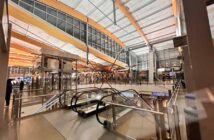
Kraków John Paul II International Airport (KRK), located 11 kilometres west of Kraków’s city centre in Balice, serves as a major hub for southern Poland, handling over 9 million passengers annually. The airport’s single terminal, renovated in 2015, offers a modern and efficient layout with domestic and international flights integrated across two levels. Arrivals and baggage claim are on the ground floor, while check-in and departures occupy the upper level, with clear English and Polish signage ensuring easy navigation. For passengers with mobility needs, the airport provides wheelchair assistance, accessible restrooms, and lifts, with support available if requested 48 hours in advance through airlines or the information desk near the main entrance.
Access to the airport is convenient, with multiple transport options connecting to Kraków and nearby areas. Regular trains run from Kraków Główny (main station) to the airport’s dedicated railway station, a two-minute walk from the terminal, taking 17 minutes for about 16 PLN (£3.20). Buses 209 and 252 link to the city centre in 40 minutes for 6 PLN (£1.20), with tickets available via mobile apps or onboard.
Taxis, stationed outside arrivals, cost around 100 PLN (£20) to central Kraków, while ride-hailing services like Uber operate from designated pick-up zones. Car rental agencies, including Avis, Hertz, and Sixt, are located in the arrivals hall, and the airport is accessible via the A4 motorway, with 1,200 parking spaces across short- and long-term lots, including a free 10-minute drop-off zone.
The passenger experience is designed for efficiency, though high traffic can create challenges. Over 60 check-in desks open three hours before international flights and two hours before domestic, closing 40 minutes prior, with self-service kiosks available for airlines like Ryanair and Wizz Air.
Security screening, with multiple lanes, averages 15 to 20 minutes but can extend to 45 minutes during peak summer months or holiday periods. Travellers should arrive two hours early for domestic and three hours for international flights to account for potential queues. Free Wi-Fi is accessible via the “Krakow Airport” network with a simple login, and charging stations are plentiful near gates and seating areas. The Business Lounge in the Schengen departure area offers snacks, drinks, and workspaces for around £25, accessible via Priority Pass or direct payment, while a quiet room and baby-changing facilities cater to families.
Dining and retail options are plentiful, with over 20 eateries and shops across the terminal. Landside, Coffee Corner and Eat & Fly serve sandwiches and coffee, with a coffee priced at about £2. Airside, restaurants like The Flame offer Polish dishes and international fare, with meals ranging from £8 to £15. Duty-free shops provide perfumes, alcohol, and local souvenirs like amber jewellery, while newsstands and boutiques sell travel essentials and gifts, open from 5 am. until the last flight. A pharmacy, currency exchange, and ATMs add convenience, with smoking areas available outside the terminal.
On-time performance is generally reliable, with most flights departing within 15 minutes of schedule, supported by a 2,800-metre runway and modern navigation systems. However, winter weather, including snow or fog, can cause delays, particularly for low-cost carriers with tight schedules. Passengers should monitor flight statuses via the airport’s app or digital boards. For connections, the single terminal simplifies transfers, with minimum connection times of 40 minutes for domestic and 60 minutes for international flights, often through hubs like Warsaw or Frankfurt. Fast-track security, available for purchase, reduces wait times for tight connections.Potential delays may arise from high passenger volumes during summer or holiday seasons, leading to crowded check-in and security areas. Slow passport control for non-Schengen flights can also cause bottlenecks, with waits of up to an hour reported. Road traffic on the A4 during rush hours may delay arrivals, so extra travel time is advised.




